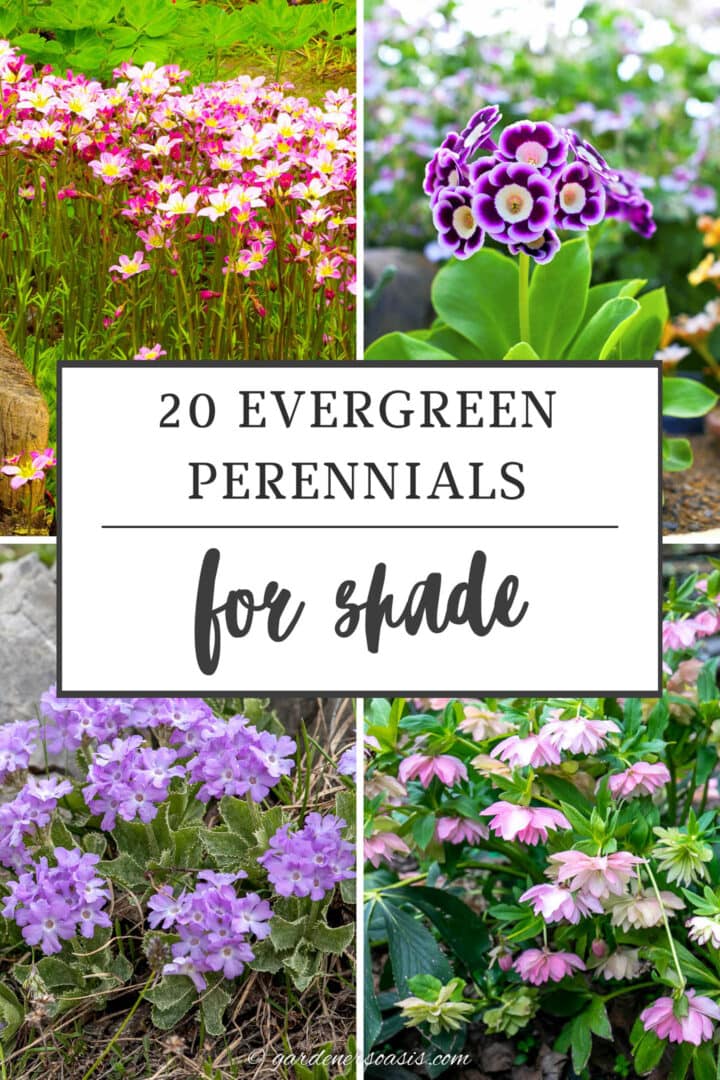20 Evergreen Perennials For Shade
Are you looking for easy-care, low-maintenance plants to spruce up your shady garden? These evergreen perennials for shade may be the perfect solution! Not only do they add interest and texture throughout the year, but they also require minimal effort while giving your garden a naturally beautiful look.
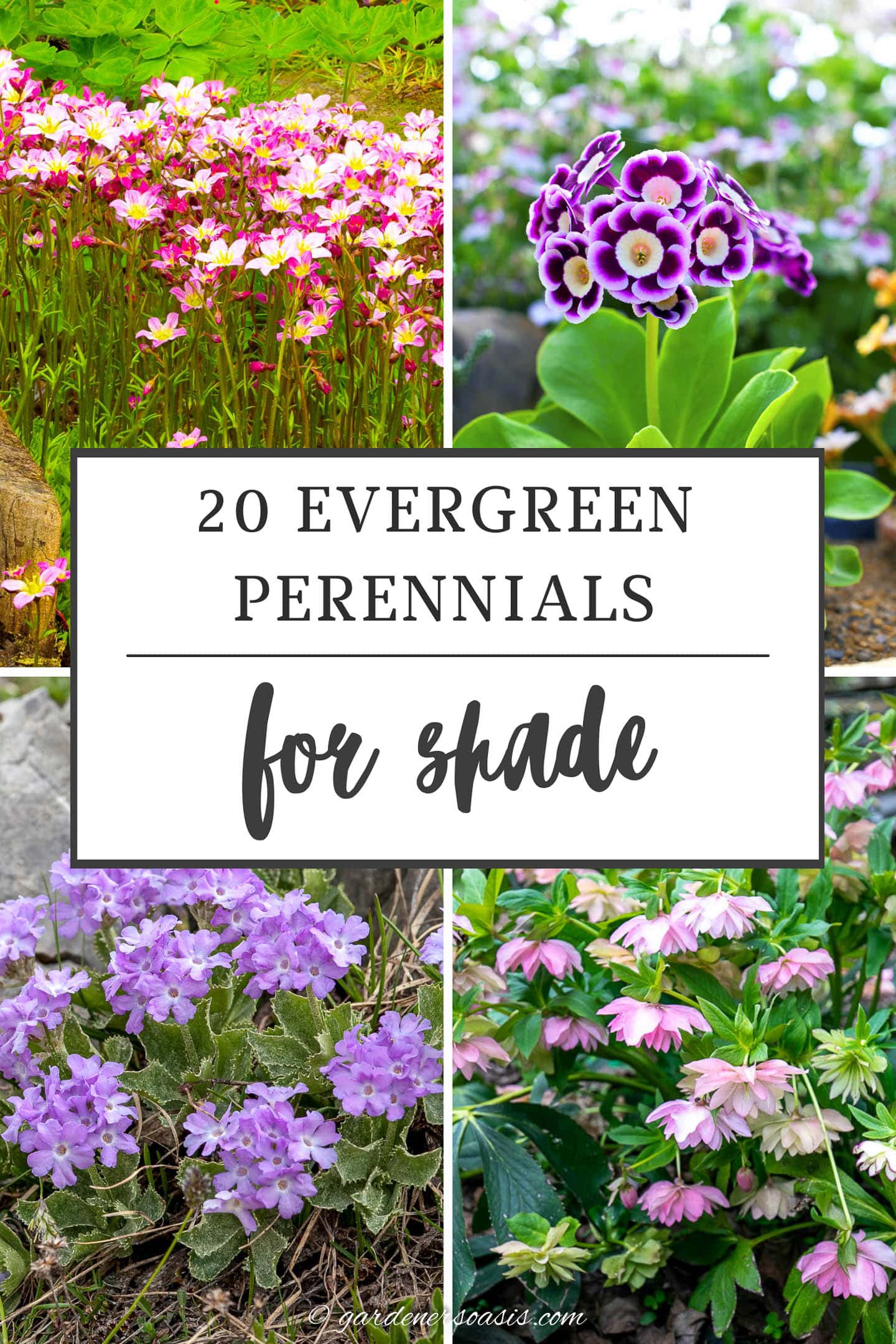
As you may know, a perennial is a plant that lives longer than two years, and most go dormant in the winter.
However, there are some perennial plants that are evergreen and keep their foliage through all 4 seasons.
I think these are an essential part of the home garden landscape design because they add a visual reprieve when the soil is bare and the atmosphere is bleak.
Since my garden is very shady, I am always looking for evergreen perennials that will do well in that environment.
Which is where this selection of evergreen perennials for shade came from.
They not only survive the low light conditions of the shady garden in summer but will add some color when it is most needed in the middle of winter.
1 | Deer fern, Hard fern
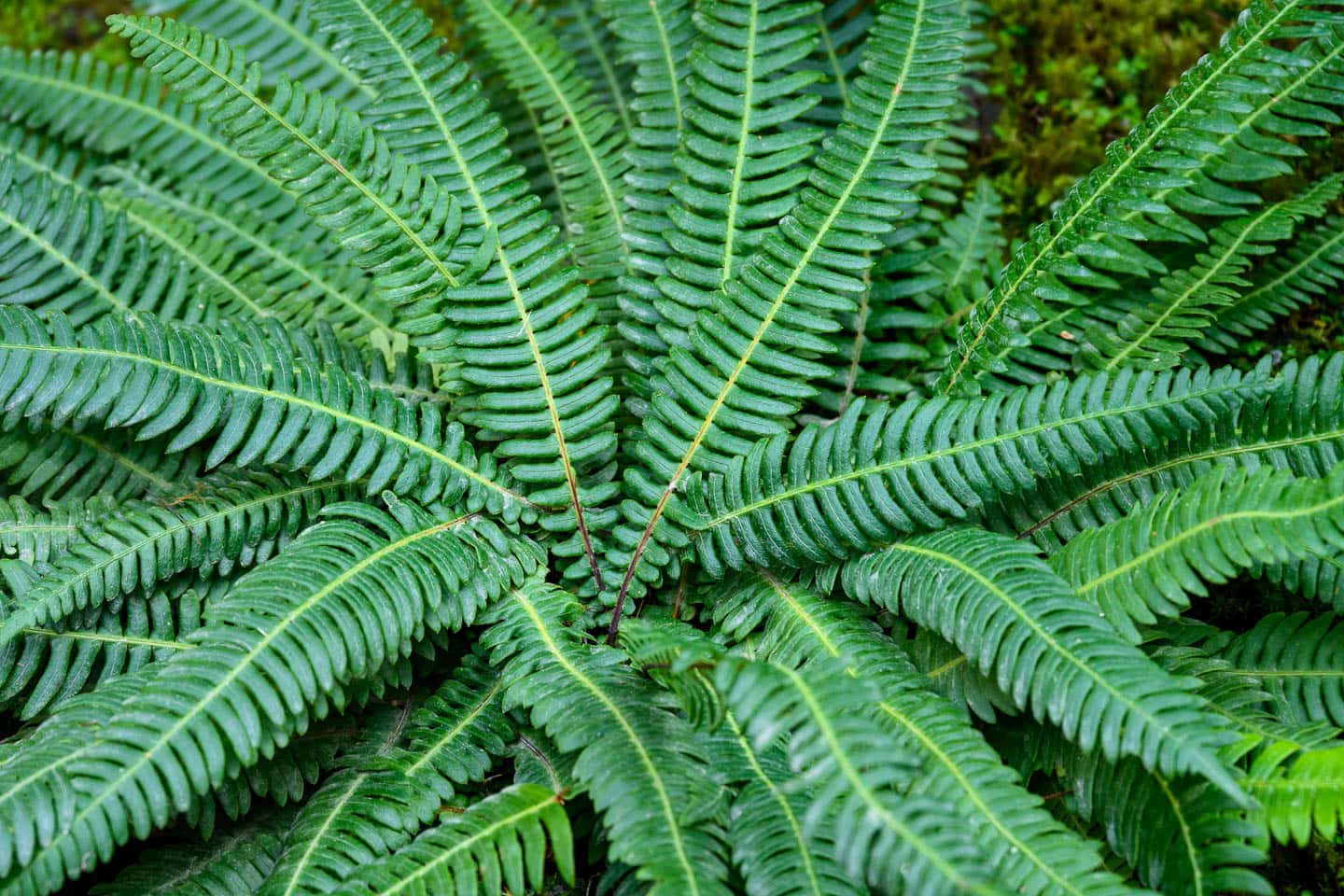
Scientific name: Blechnum spicant
Zone: 5 to 8
Exposure: full shade
Height: 9″ – 18″
Width: 1′ – 2′
Bloom time: non-flowering
Bloom color: non-flowering
Deer fern is native to Northwestern North America and Europe.
It is interesting in that it has 2 sets of fronds.
The sterile stiff dark green evergreen fronds grow outward facing in a flattened rosette.
In the summer, fertile longer, thinner fronds emerge from the center vertically.
Later in the season, they turn brown and die, leaving the evergreen, sterile green rosette.
Blechnum spicant likes humous rich, acidic, moist, well drained soil in deep shade.
It spreads slowly by rhizomes and is propagated by division.
It will even tolerate clay soil if given enough moisture and makes a nice addition to the shade border or rock garden.
In spite of the name, it is not favored by deer or rabbits.
2 | Winter glow Bergenia, pig-squeak
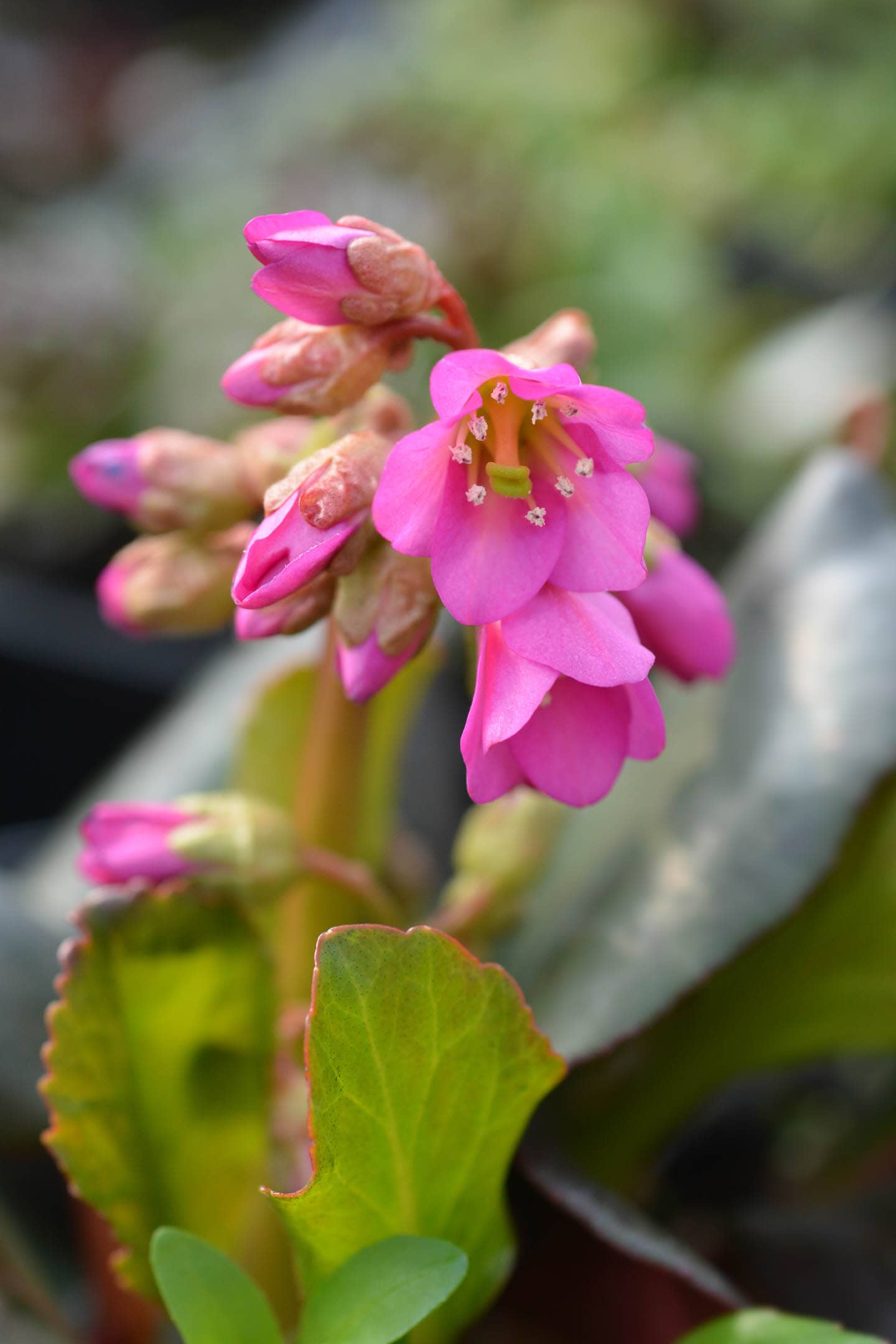
Scientific name: Bergenia cordifolia ‘Winterglut‘
Zone: 4 to 8
Exposure: full shade
Height: 12″ – 18″
Width: 12″ – 18″
Bloom time: April to May
Bloom color: Magenta-red
A member of the saxifrage family, winter glow Bergenia is noted for its large, glossy, leathery, dark green leaves that turn burgundy/bronze in fall and winter.
In early spring a thick stalk shoots up above the foliage bearing dense panicles of small reddish flowers.
This plant provides an exotic looking welcome change among the ‘little' leaves of other border plants and is a great choice for edging a pathway.
Grow it in humous rich, consistently moist soil with good drainage in a shady spot.
Remove winter damaged leaves in the spring and cut the flower stalks as soon as they are spent.
Bergenia spreads slowly by rhizomes and is easy to grow from seed.
The leaves are often used in bouquets by florists.
It is ignored by deer and rabbits.
3 | Golden male fern
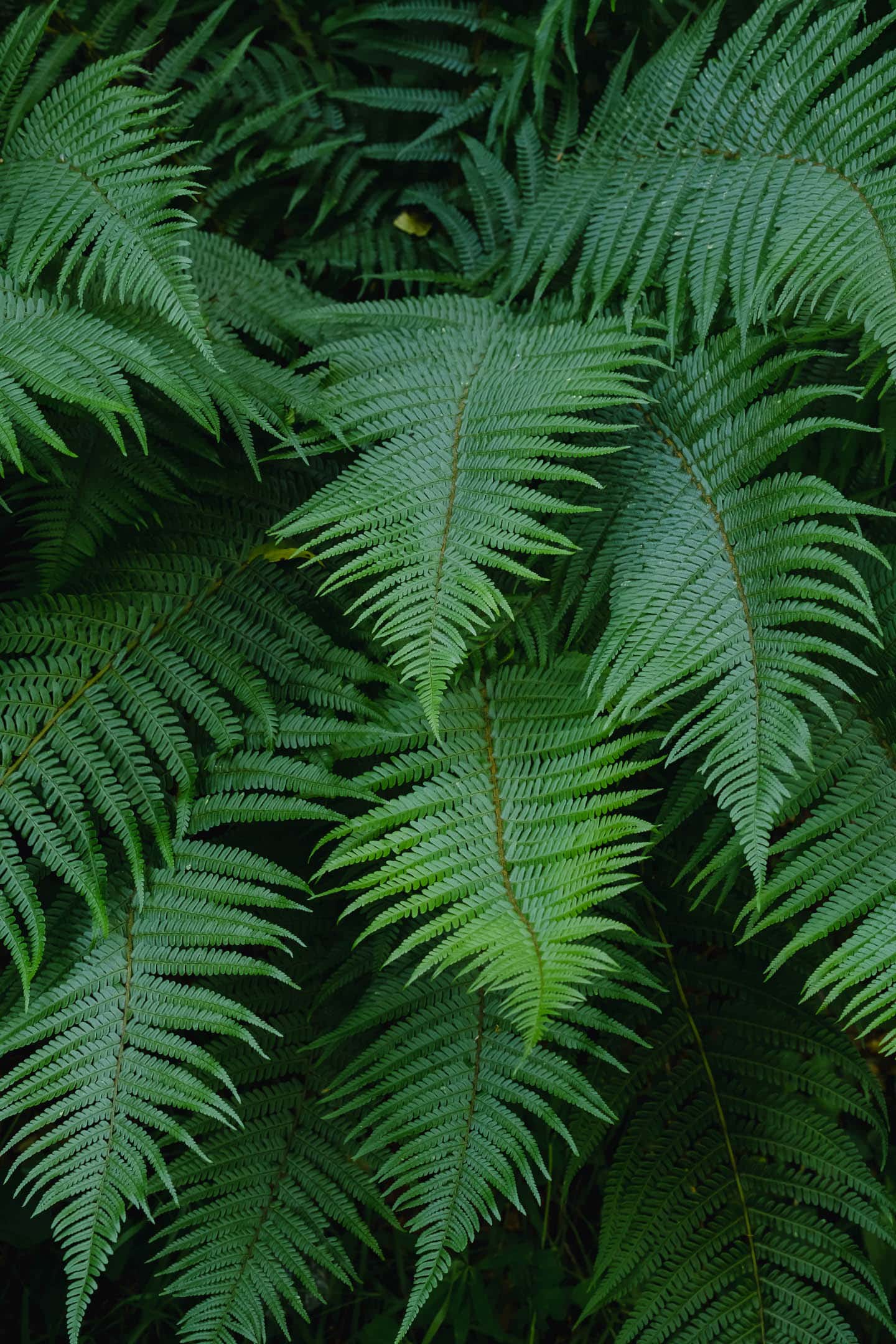
Scientific name: Dryopteris affinis
Zone: 6 to 8
Exposure: shade
Height: 3′ – 4′
Width: 3′ – 4′
Bloom time: non flowering
Bloom color: non flowering
Golden male fern is a striking large plant with long, arching, finely cut fronds that are a lovely chartreuse color in the spring.
They become dark green as the summer progresses.
And make a great statement in the shady understory of shrubs.
Dryopteris will grow in any moist, well draining soil.
They are drought tolerant once established.
Propagate by division in the spring.
This disease free, easy care plant only needs to have dead and broken fronds removed.
It is an RHS Award of Merit winner.
4 | Mondo grass
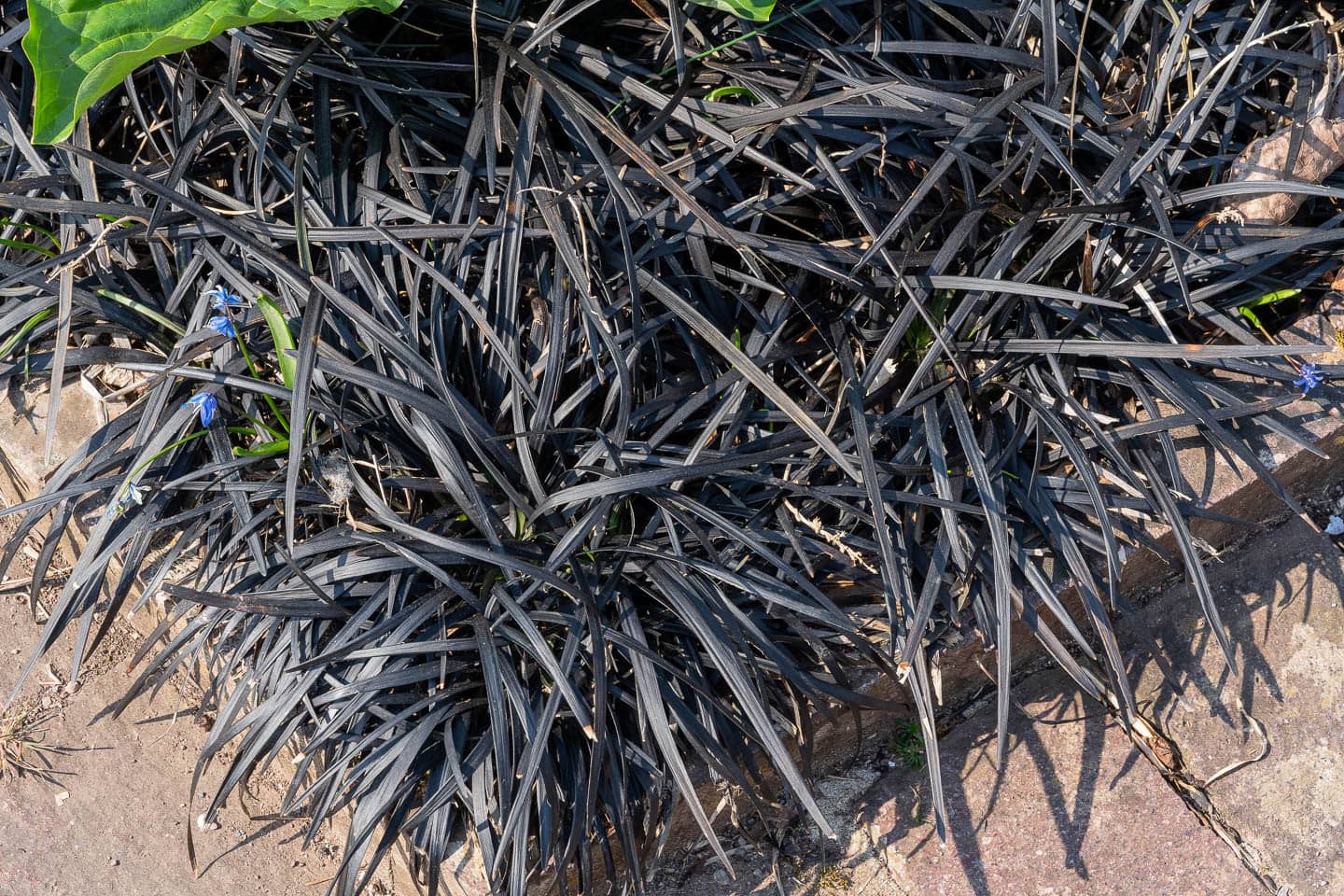
Scientific name: Ophiopogon planiscapus
Zone: 6 to 10
Exposure: shade, part shade, sun
Height: 4″ – 15″
Width: 6″ – 15″
Bloom time: summer
Bloom color: pink, white
Mondo grass is an evergreen perennial for shade that can be planted under large trees where it will form tuffs of green or black stiff short blade-like foliage.
Light affects its color, with black varieties becoming greener in deep shade.
It spreads slowly by stolons under the surface which produce little daughter plants at their ends.
To propagate, dig up a plant, pull it apart in sections of several rhizomes and about 10 leaves.
Then plant each section in moist, humus rich, well drained soil that has been amended with compost.
Water deeply and regularly. Mondo grass does not tolerate drought and needs water weekly.
Small pinkish flowers will appear among the blades in summer, followed by black shiny berries in fall.
In spite of its name, it is not a grass at all. It is a member of the lily family.
Mondo grass is tough. It tolerates foot traffic, black walnut, deer, rabbit, deep shade, salt.
However, it is considered invasive in the Southern USA.
5 | Snowy Woodrush
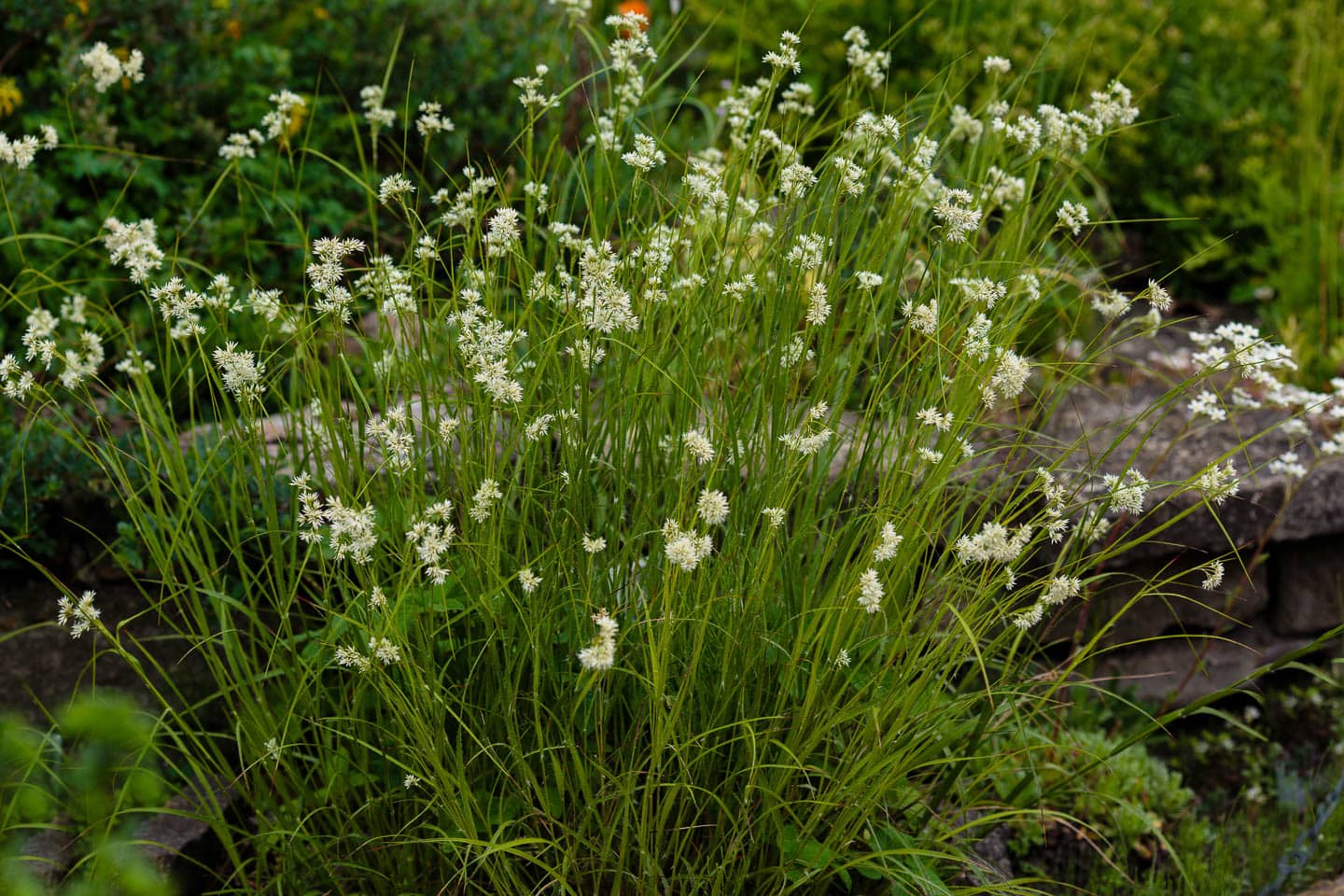
Scientific name: Luzula nivea
Zone: 4 to 9
Exposure: partial sun, shade
Height: 2′
Width: 18″ – 24″
Bloom time: early to mid summer
Bloom color: white
Luzula looks like a grass with its narrow, rich, green blades and loosely formed clumps.
However, it is actually a rush that sports dense clusters of white flower spikes mid-summer.
It self seeds readily.
Snowy woodrush grows in poor to humus rich, moist, well drained soil and will tolerate dry shade.
This easy care, low maintenance plant is great for edging shady paths.
6 | Lungwort
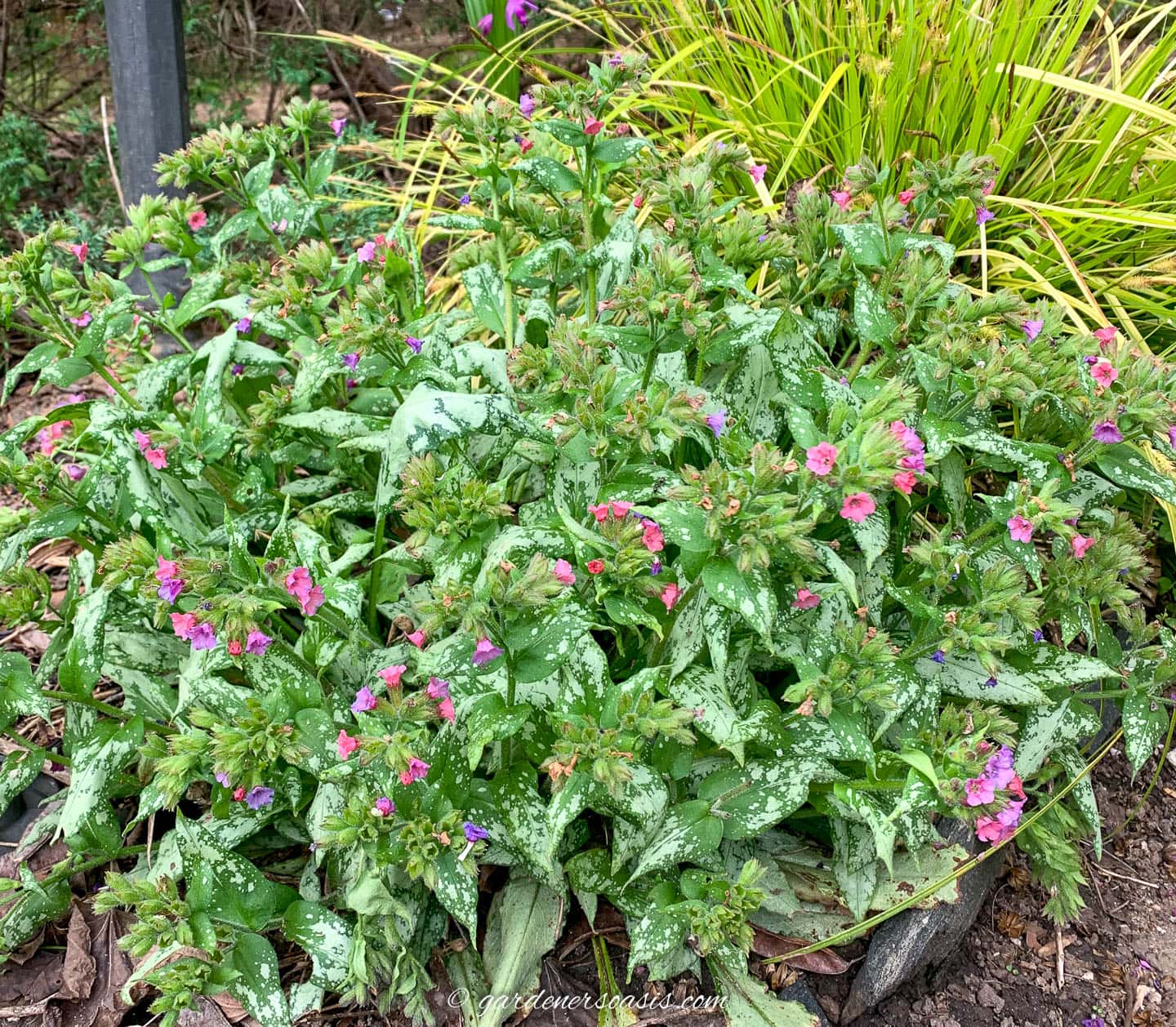
Scientific name: Pulmonaria officinals
Zone: 3 to 8
Exposure: shade
Height: 8″ – 12″
Width: 1′ – 2′
Bloom time: spring
Bloom color: blue, pink, red, white, purple
Lungwort is an attractive easy care plant that is evergreen in mild climates.
The fuzzy dark-green leaves are heart-shaped or ovate, grow up to 12″ long and are often spotted enough to make them appear silver.
Funnel shaped spring blooms, which start out pink and turn blue at maturity, attract hummingbirds.
The plant is a welcome addition to cottage shade gardens and borders.
It grows in any consistently moist soil. The right amount of moisture being the key requirement.
Companion plant with hellebores, primrose, hosta, and holly fern.
It spreads slowly by rhizomes and is propagated by division in the fall.
My pulmonaria readily self seeds but not true to the original hybrid. However, it is not invasive.
Rejuvenate the appearance of evergreen varieties by shearing the leaves off after they finish blooming.
The edible leaves can be added to salads.
Pulmonaria is resistant to black walnut, deer, rabbits and deep shade.
The variety Pulmonaria ‘Blue ensign' has won the RHS Award of Merit.
7 | Primrose
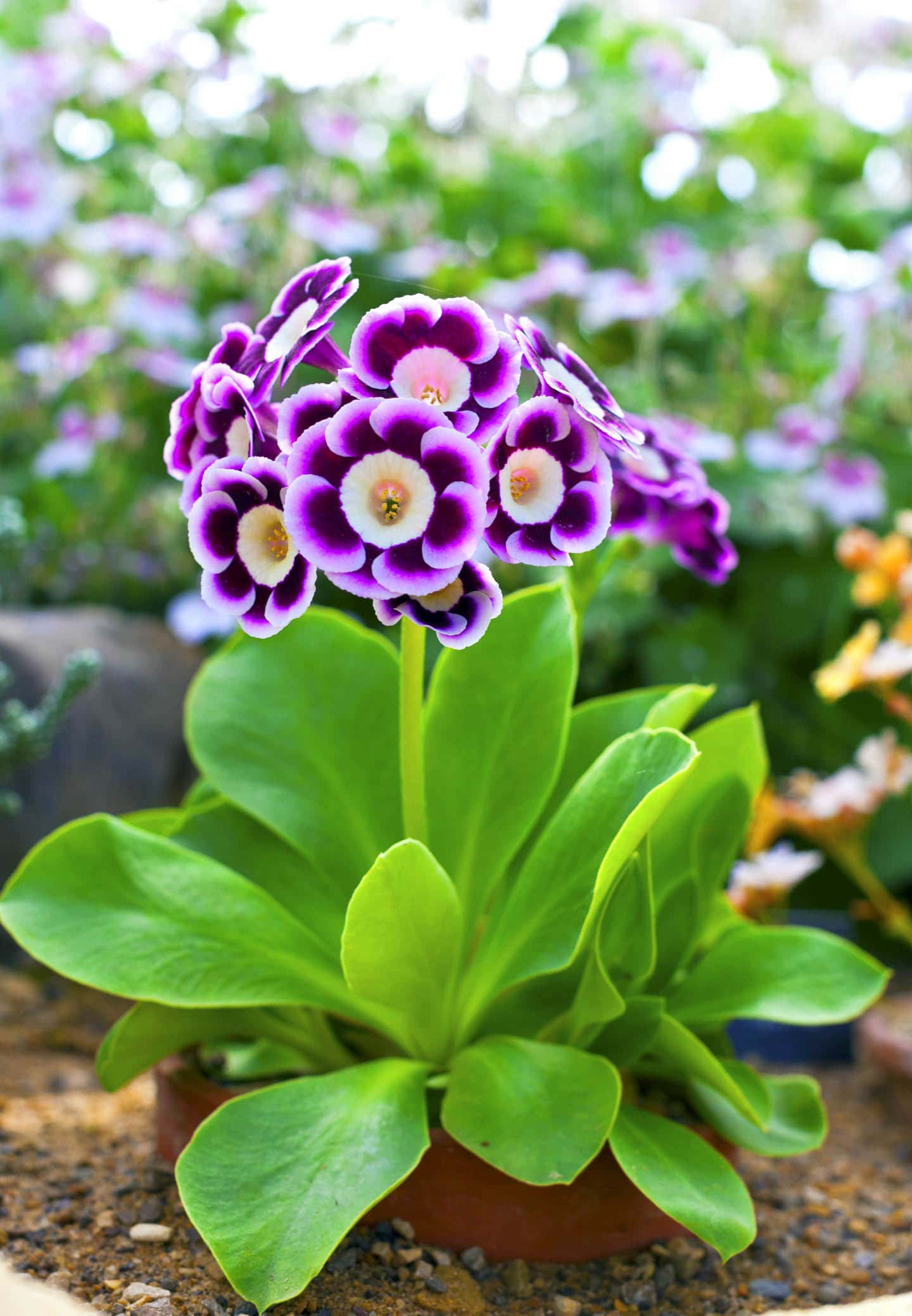
Scientific name: Primula
Zone: 2 to 8
Exposure: part shade, shade
Height: 4″ – 20″ depending on the variety
Width: 12″
Bloom time: early spring, into early summer if deadheaded
Bloom color: pink, blue, purple, red, white
There are over 400 species of primrose, plus many hybrids.
Some are annuals, some are perennials, some are shade tolerant while others like more sun, some are evergreen, etc. so it is essential to carefully read the nursery tags when buying.
Generally, primula like consistently moist, humus rich acidic soil and a shady location.
They are cool weather plants that tend to wilt in the summer, especially if not given extra water.
They benefit from a layer of mulch to keep the roots cool and retain moisture.
One of the first plants to bloom in the spring, they will repeat bloom until it gets really hot, if regularly deadheaded.
Divide the plant every 4 to 5 years by separating the roots into sections.
These easy care must-have little plants should be sited near paths where their delicate scent and bright, cheerful flowers can be appreciated.
Leaves are edible and can be added to salads.
Companion plant with Japanese painted fern, lungwort, and heuchera.
Silver-edged Primrose
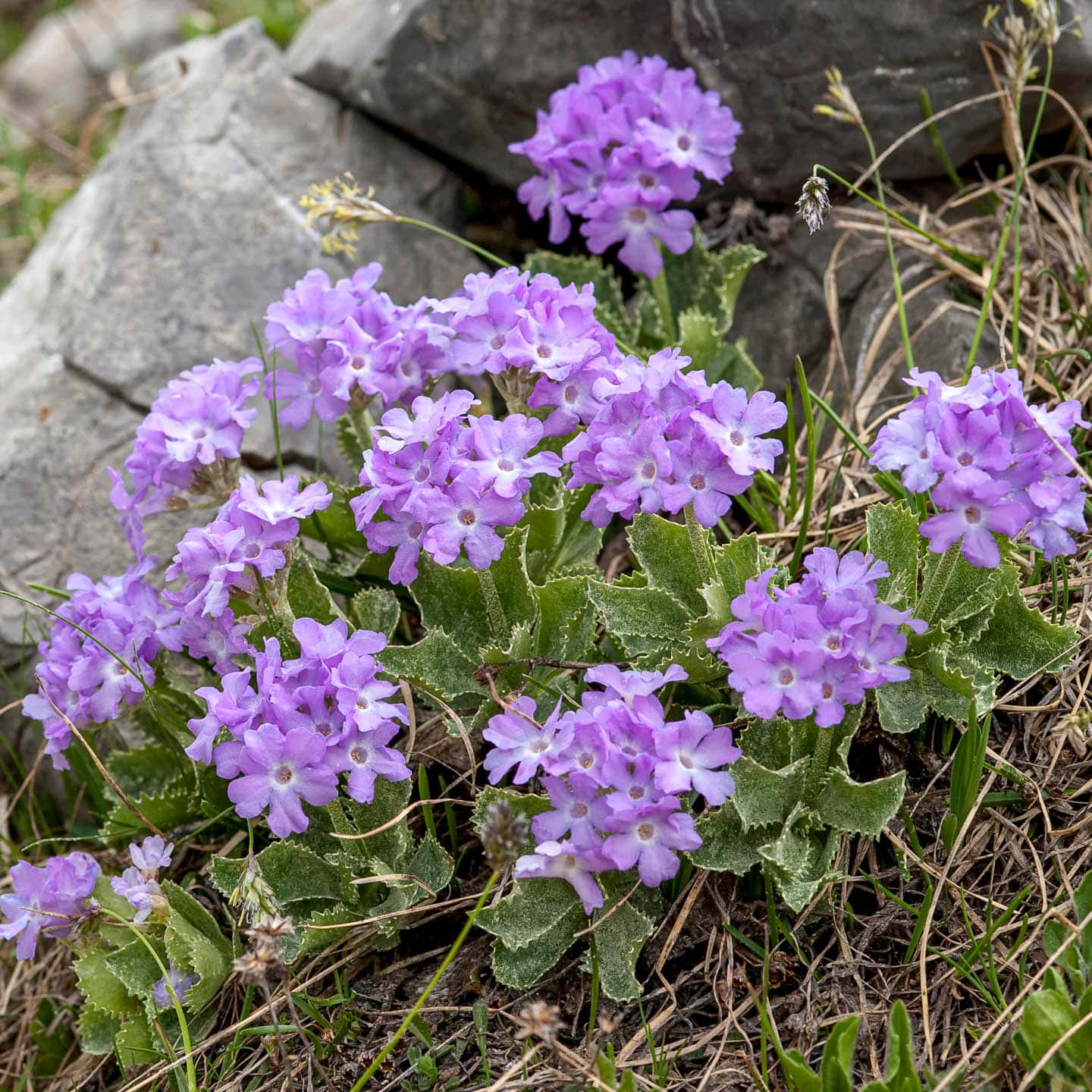
Scientific name: Primula marginata
Zone: 3 to 8
Exposure: part shade
Height: 6″
Width: 12″
Bloom time: late winter, early spring
Bloom color: blue-lilac
Primula marginata is distinguished from other primulas by its rosette of white- edged silvery evergreen leaves that provide year round interest.
Very early in the spring, blue-lilac, 1 1/2″ wide scented flowers rise above the foliage. Gorgeous!
8 | Lily turf, monkey grass
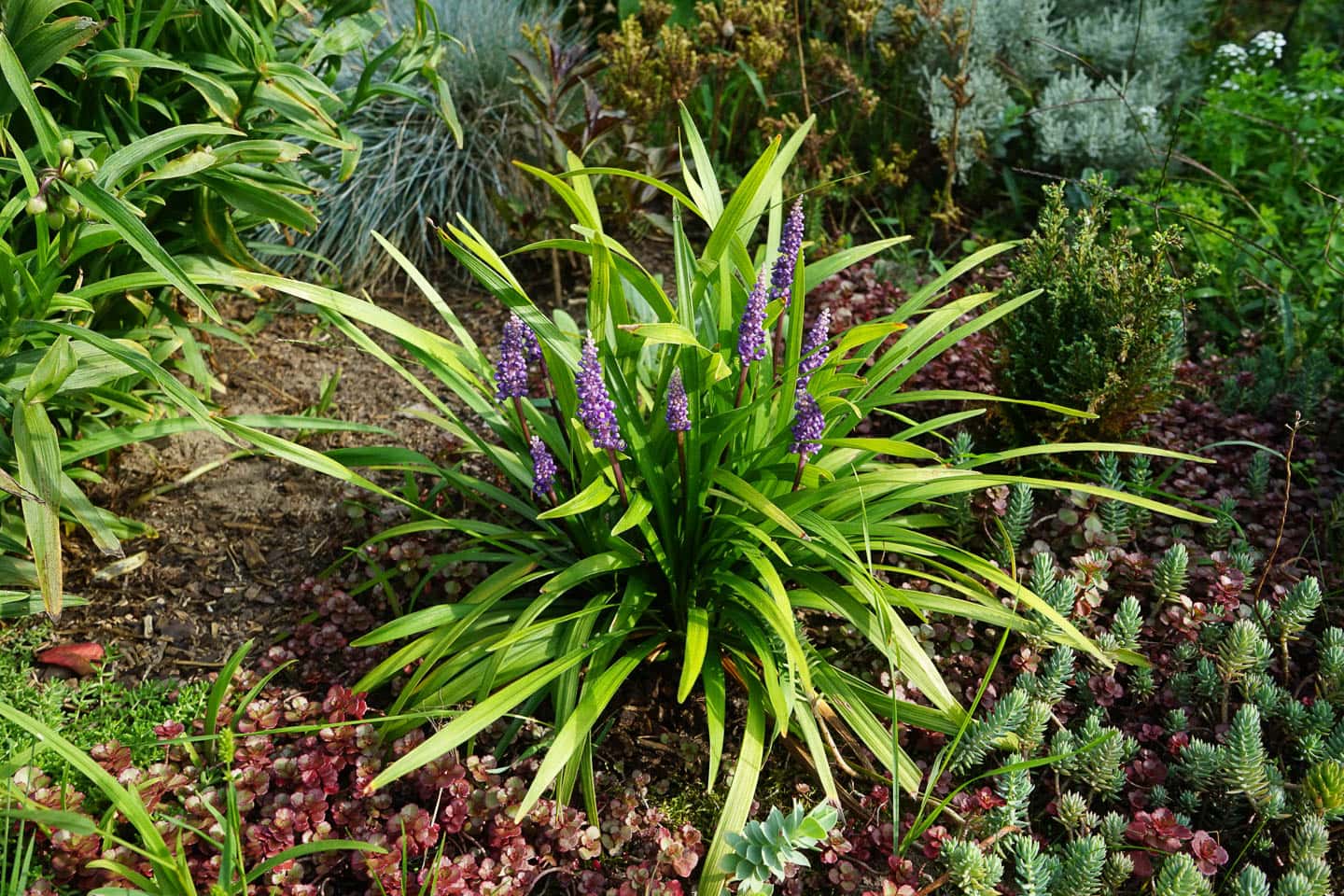
Scientific name: Liriope muscari
Zone: 5 to 10
Exposure: shade to full sun
Height: 12″ – 18″
Width: 12″ – 24″
Bloom time: late summer
Bloom color: blue/purple
Liriope is a tough grass-like low maintenance perennial that has dark green or variegated blades.
The grape hyacinth shaped flowers bloom for a long time in late summer and into fall.
Grow in moist, compost amended well drained soil. Drought tolerant once established.
The tufts of ‘Variegata' and ‘Big Blue' behave well as edging because they stay put and do not send out runners into adjacent plants.
Cut off spent blooms in the fall to tidy its appearance.
Shear the foliage in early spring to rejuvenate and encourage new growth.
Propagate by division in the spring. Avoid overhead irrigation to prevent fungal disease from developing.
The flowers attract birds, bees, butterflies, and hummingbirds.
Deer and rabbits leave lily turf alone.
9 | Golden variegated sweet flag
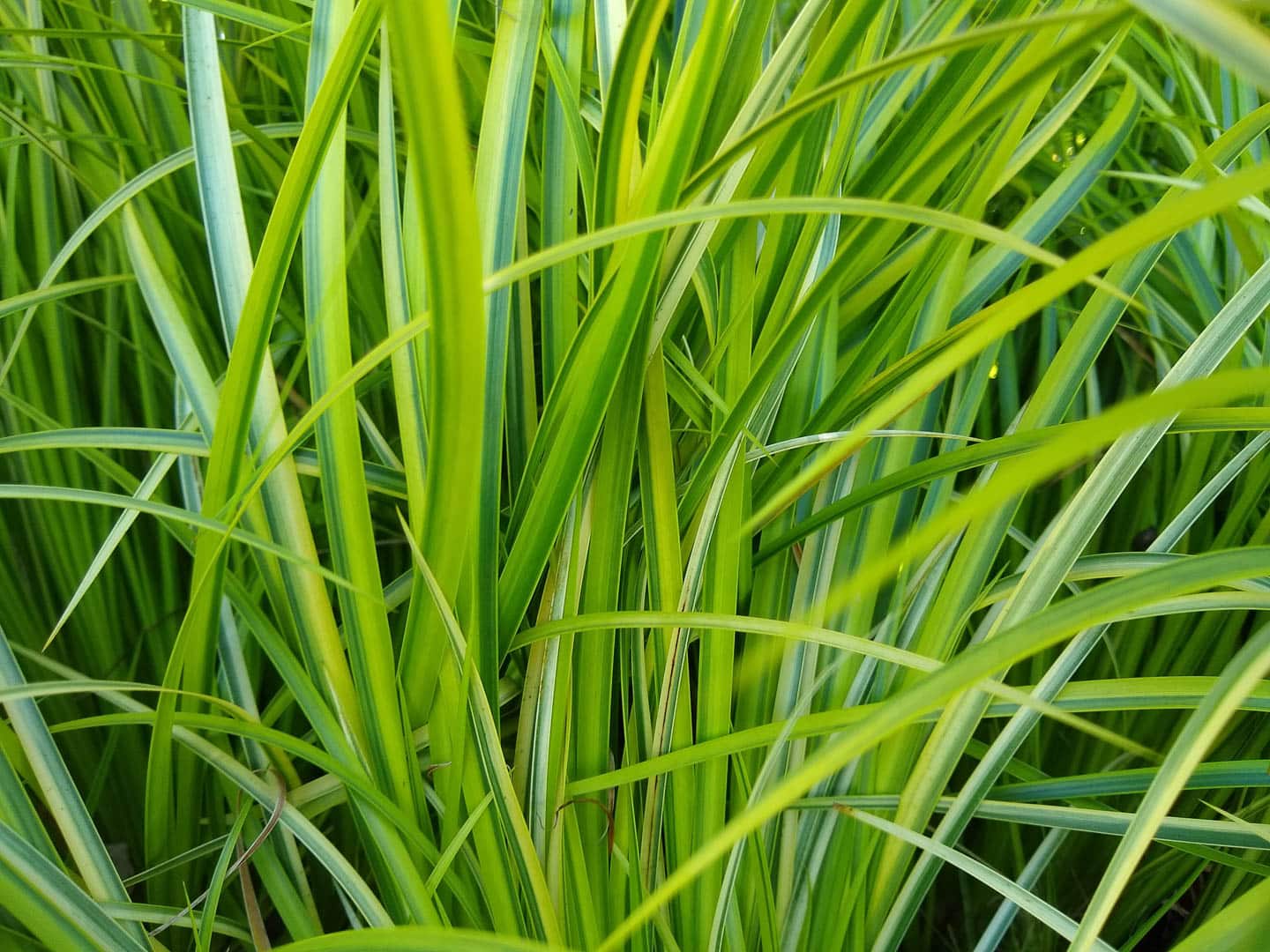
Scientific name: Acorus gramineus ‘Ogon'
Zone: 5 to 9
Exposure: part shade, shade
Height: 6″ – 12″
Width: 6″ – 12″
Bloom time: June to July
Bloom color: greenish yellow
Ogon is a striking dwarf Far East native sweet flag that has variegated gold and yellow narrow grass-like leaves.
It grows in tufts in consistently-moist garden soils or boggy soil. The plants should never be allowed to dry out.
This evergreen shade perennial can also be grown in water gardens (with shallow standing water up to 4″ deep) where it is often planted into pots that are sunk beneath the water's surface.
It is a low maintenance plant that only needs dividing every few years.
10 | Sedge
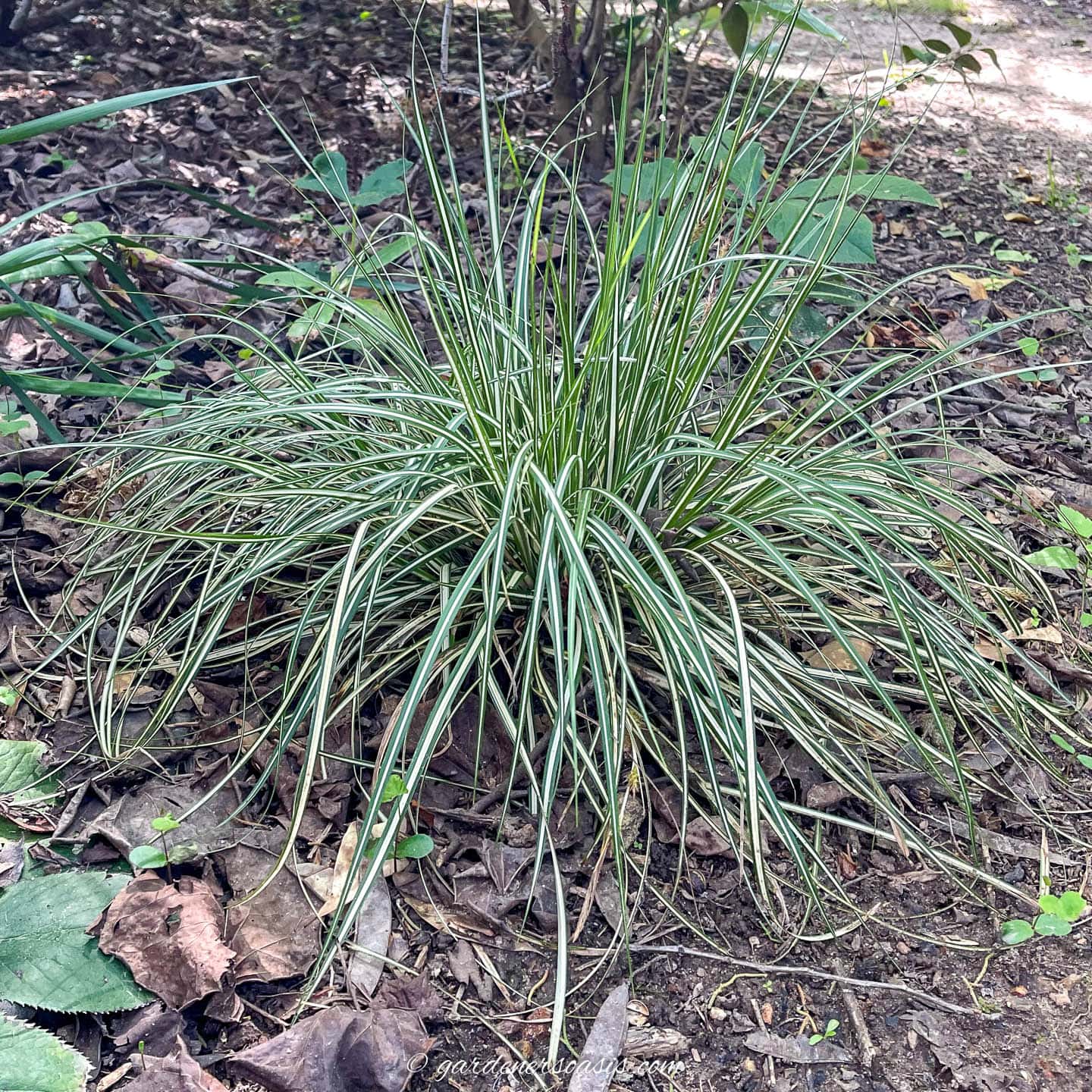
Scientific name: Carex, C. morrowii
Zone: 5 to 9
Exposure: partial sun, shade
Height: 9″ – 12″
Width: 12″ – 18″
Bloom time: insignificant brown
Bloom color: beautiful foliage — dark green, yellow, bronze, variegated
Carex is a grass-like clumping evergreen shade plant with flat, narrow (1/4″ – 1/2″ wide) blades that spreads slowly by rhizomes.
It drapes over the large border pebbles in my back yard and provides gorgeous movement and color to the shady space.
Sedge does best in humus rich, consistently moist soil, but will tolerate some drought.
The most spectacular foliage color is achieved in part-shade.
Propagate by division in the spring.
This perennial pairs well with hostas and is deer tolerant.
There are a huge number of varieties available, so be sure to read the labels in order to purchase ones that suit your environment.
11 | Barrenwort, Bishop's hat
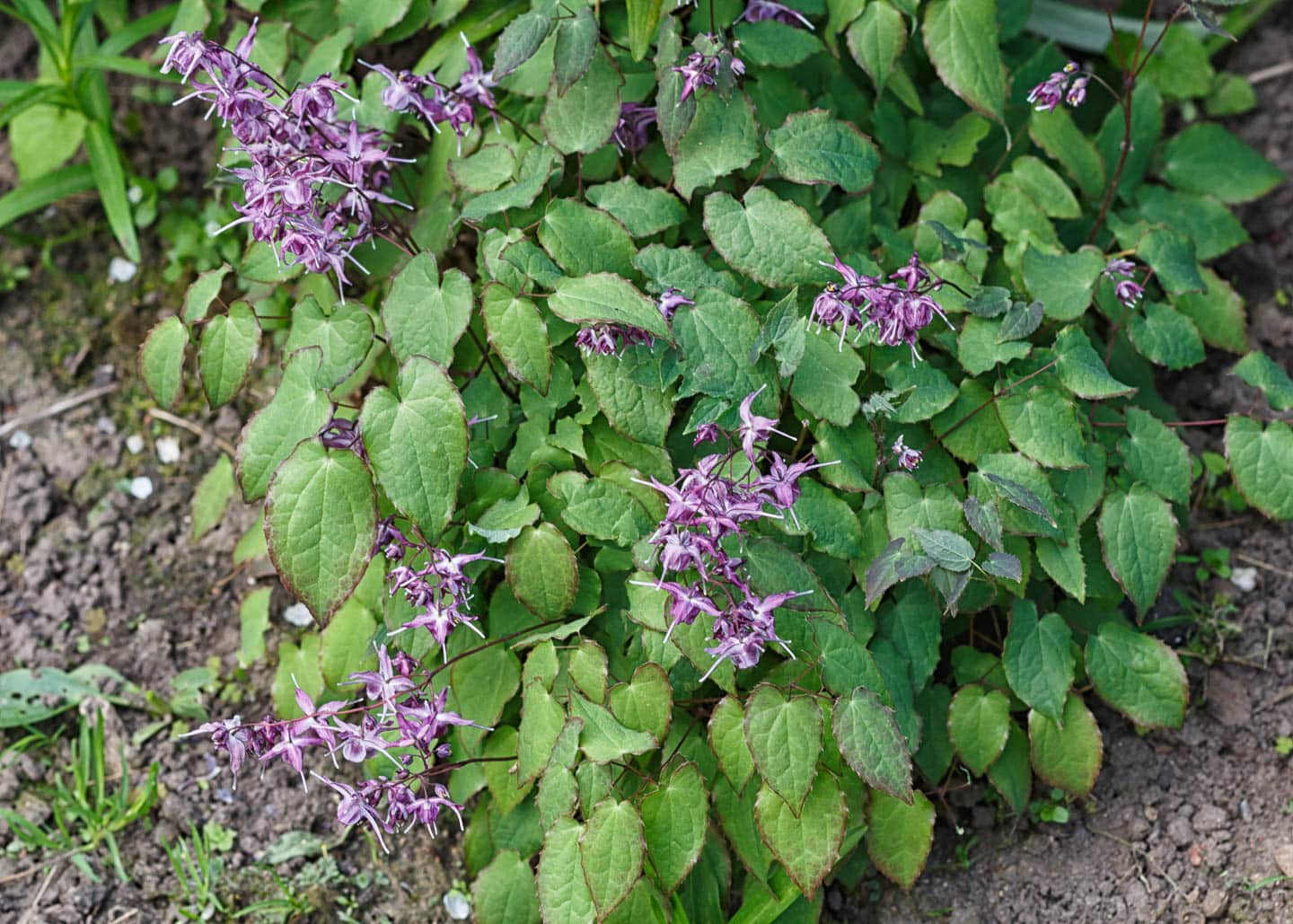
Scientific name: Epimedium
Zone: 5 to 9
Exposure: full or part shade
Height: 8″ – 12″
Width: 8″ – 12″
Bloom time: mid – late spring
Bloom color: white, purple, yellow
Bishop's hat is a small, tough dark green plant that thrives in dry shade.
New leaves in spring are a pretty bronze speckled with red, topped with clouds of small white and yellow flowers shaped like a bishop's hat.
Grown in any well drained soil, it forms a dense slow spreading clump in the front of the border.
Trim back the foliage in late winter to allow the showy new growth to shine.
Epimedium is drought, deer and rodent resistant.
It can be deciduous or evergreen so read labels carefully.
Epimedium stellulatum ‘Wudang Star' is an evergreen variety.
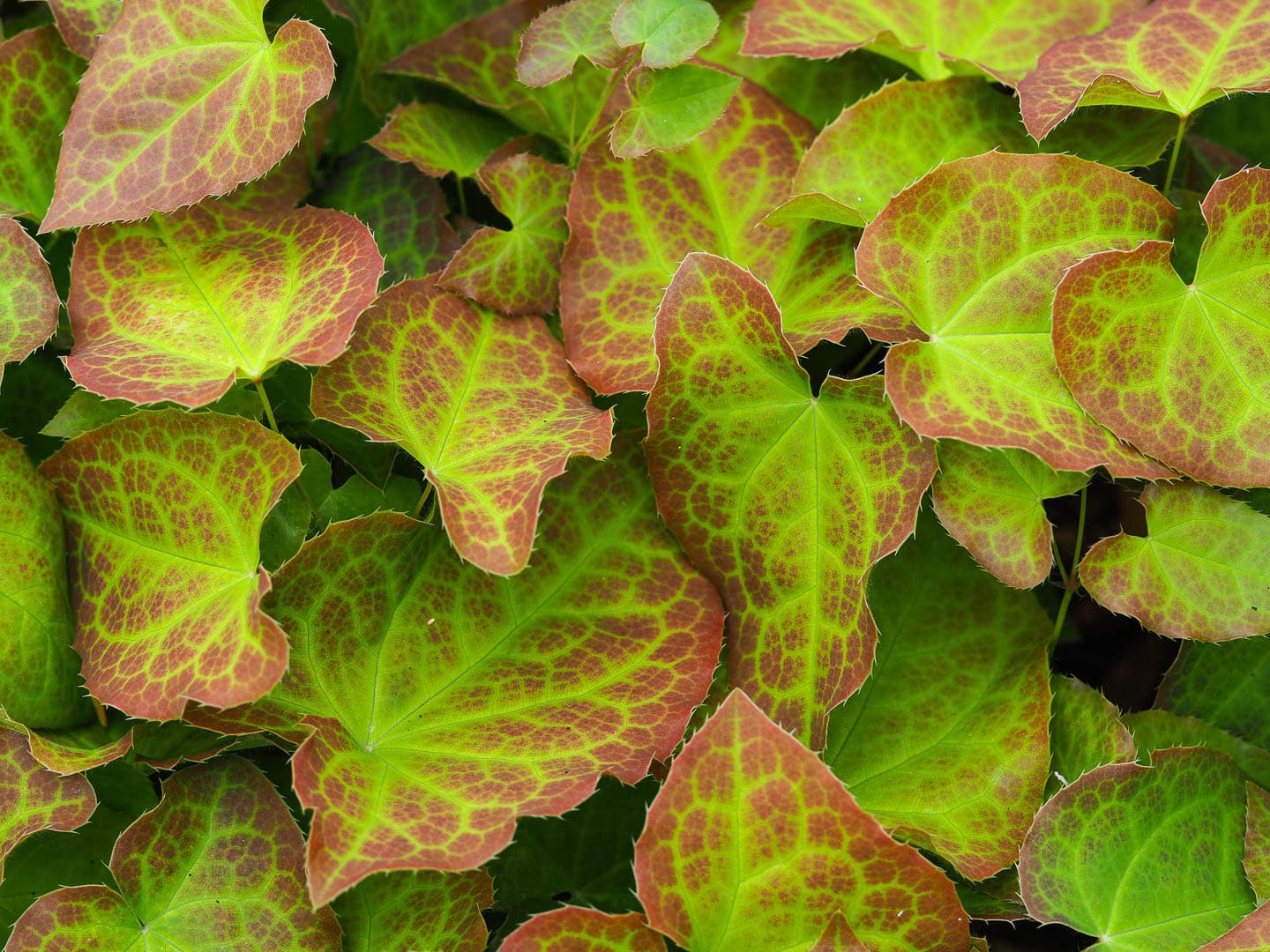
Epimedium versicolor has multi-colored leaves that are evergreen in warmer climates
12 | Wood spurge
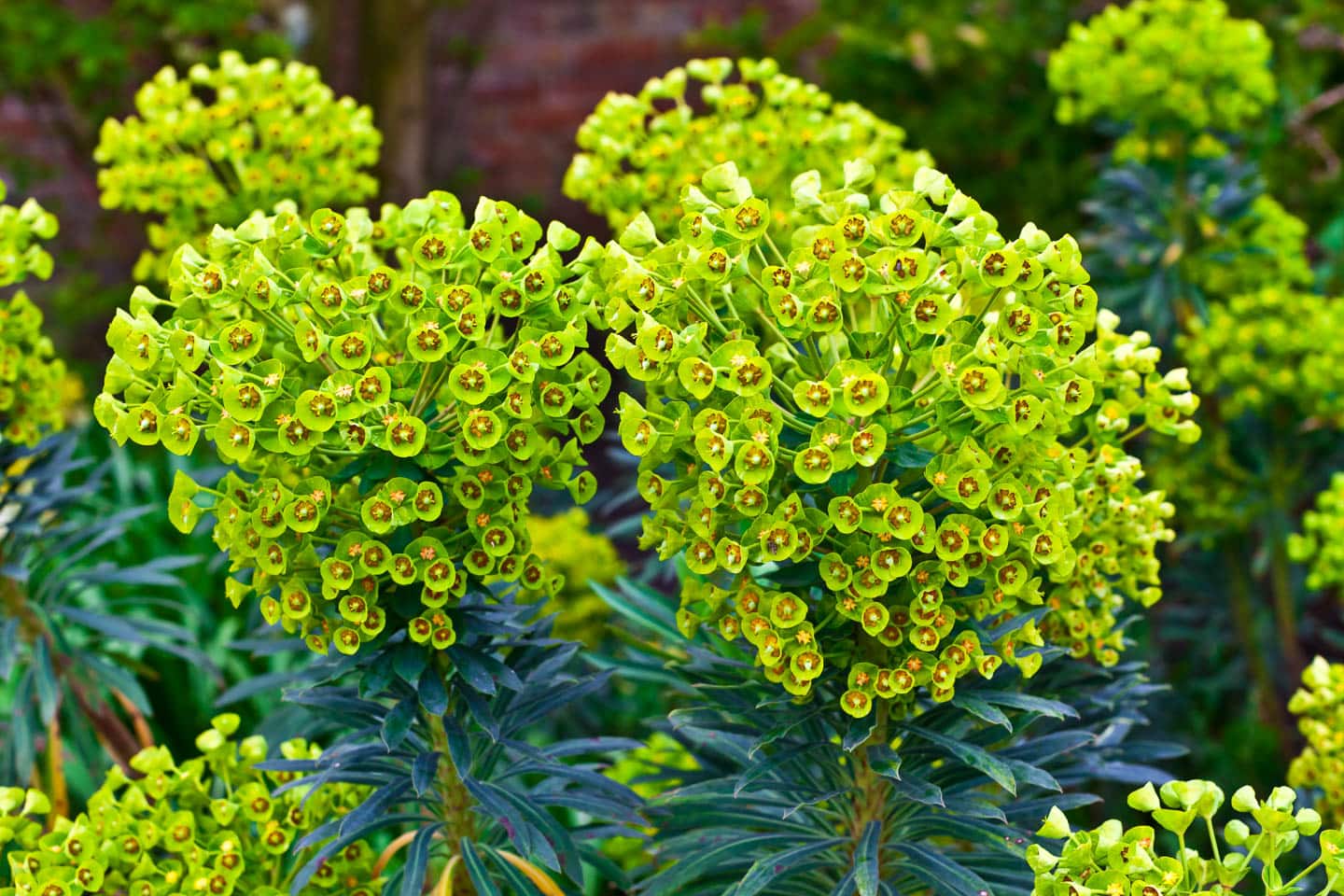
Scientific name: Euphorbia amygdaloides
Zone: 6 to 8
Exposure: part shade
Height: 18″ – 24″
Width: 9″ – 18″
Bloom time: April to June
Bloom color: lime-green
Spurge grows best in sharp, well drained, dry soil with afternoon shade.
The clump opens up and looses its tidy appearance in deep shade and wilts in the heat of afternoon sun.
The matte, 3″ roundish green leaves turn burgundy/purple in the fall.
The characteristic yellow-green flowers are borne on showy bracts and are long lasting.
They need to be deadheaded to prevent prolific self seeding.
Wear gloves when pruning spurge. The milky white sap in the stems is a skin irritant and poisonous to humans and pets.
It does well in rock gardens or other dry places.
Euphorbia is deer, rabbit, and drought tolerant.
13 | Leopard plant
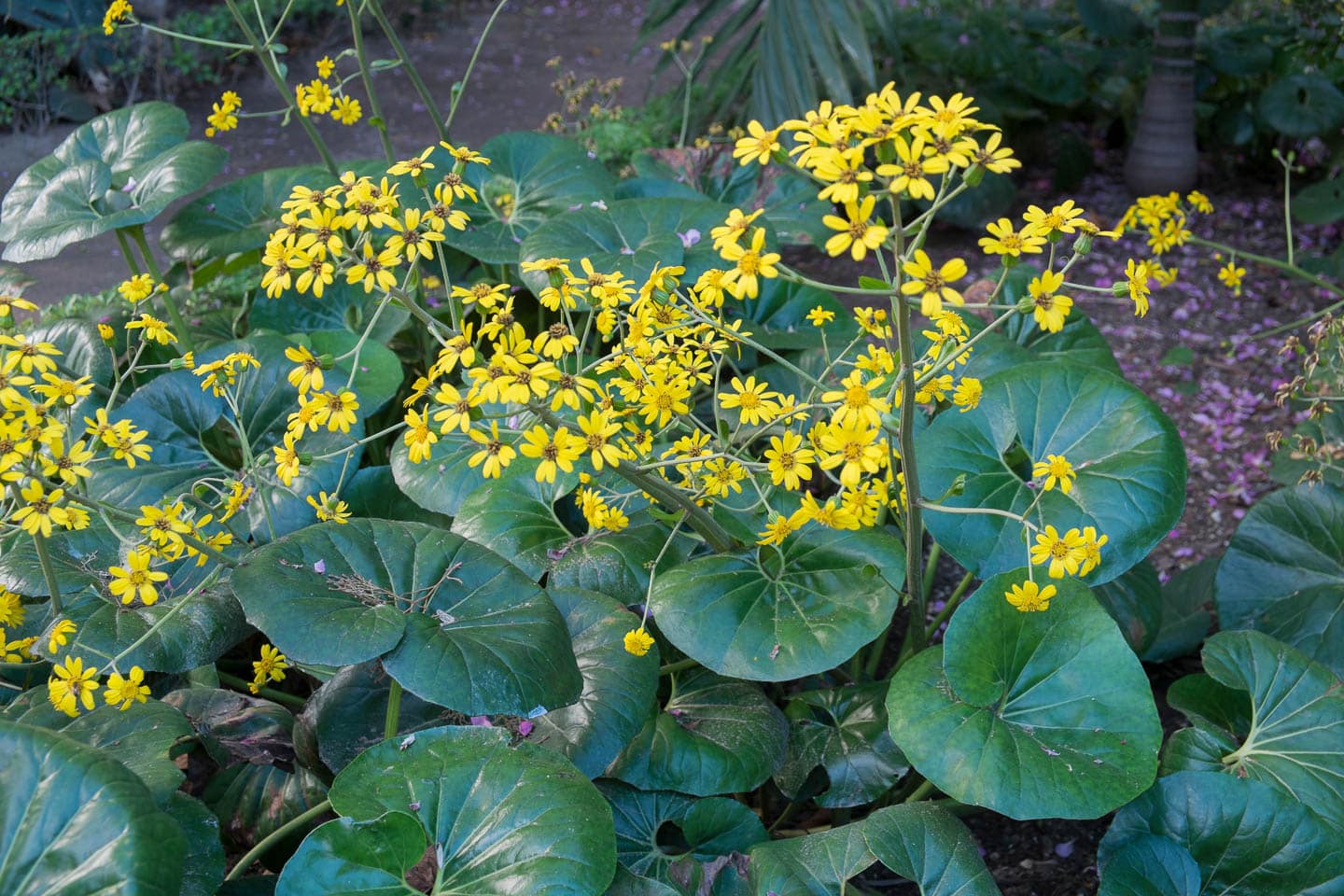
Scientific name: Farfugium Japonicum. Also known as Ligularia tussilaginea and Ligularia kaempferi
Zone: 7 to 10
Exposure: shade
Height: 2′
Width: 2′
Bloom time: fall, early winter
Bloom color: yellow
Farfugium is a stunning addition to the woodland garden or pond edge.
It forms a clump of amazing 12″ wide leathery, shiny, dark-green, kidney-shaped leaves.
Some varieties have white or yellow spots on the leaves, hence the name ‘leopard plant'.
In the fall, branches of daisy-like yellow flowers attract bees and butterflies.
Leopard plant needs humus rich, consistently moist, well drained soil in a spot sheltered from strong drying winds. It will wilt if the soil dries out.
Propagate by division in the spring.
Deer ignore farugium.
Fine textured shade loving plants like ferns, astilbe, columbines, and hostas provide good contrast as companion plants.
This underutilized beauty used to be named Ligularia, and is sometimes still called that.
14 | Lenton Rose
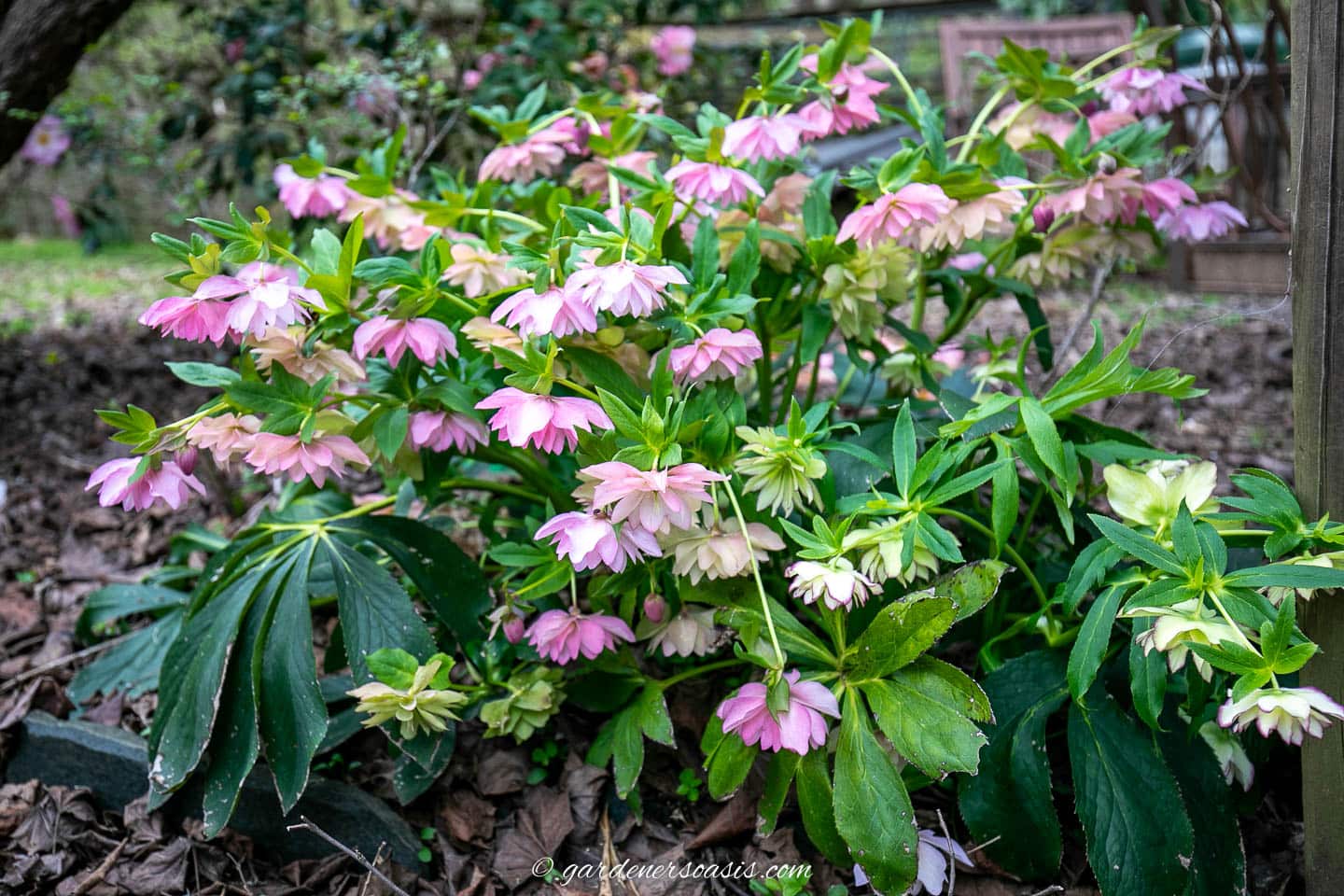
Scientific name: Helleborus
Zone: 4 to 10
Exposure: part sun, shade
Height: 18″ – 24″
Width: 18″ – 24″
Bloom time: winter, early spring
Bloom color: pink, yellow, white, cream, green, maroon, purple, spotted, speckled or near-black
Hellebores are one of my favorite plants for their variety of saucer shaped single and double flowers that bloom in the bleakness of winter and early spring.
The flowers last a long time, up to 8 weeks at least.
Hellebore likes humus rich, well drained soil with consistent moisture (about an inch of water a week).
They are very easy care plants that do not like to be moved or planted too deep. Plant the root ball just under the surface of the soil and mulch well.
I periodically tidy the plant by removing dead leaves.
Use as edging plants in the shady border where the downward facing blooms can be seen and appreciated.
These perennials are deer, rabbit and salt tolerant, and poisonous to humans, dogs, cats, and horses.
15 | Coral Bells
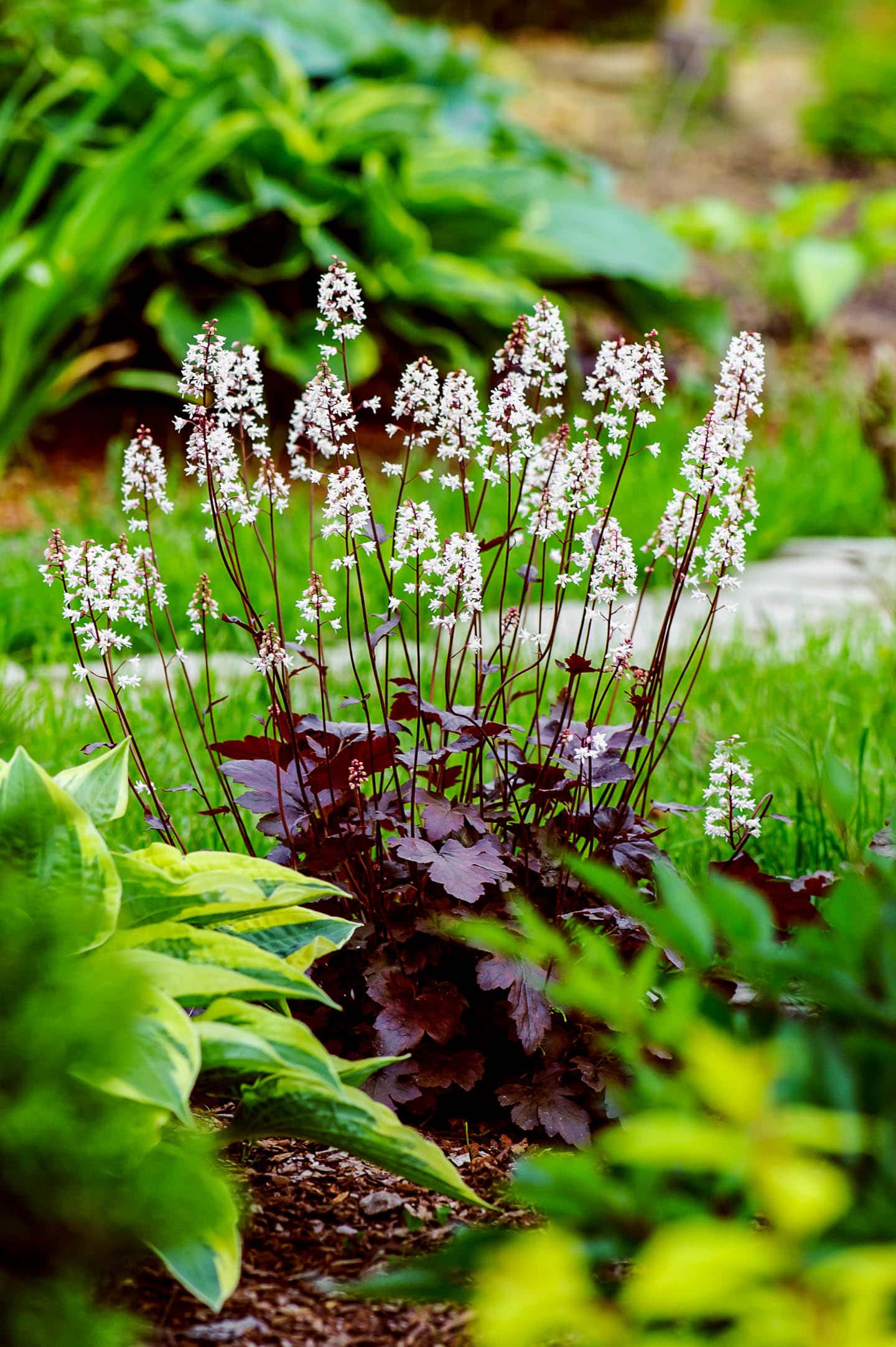
Scientific name: Heuchera
Zone: 4 to 9
Exposure: partial shade, shade
Height: 6″ – 16″
Width: 12″ – 36″
Bloom time: spring through early summer
Bloom color: coral, red, pink, white
Heuchera is a popular evergreen shade plant because of its many choices of colorful leaves.
From silver to nearly black and ruffled, wavy, smooth or patterned, it provides an opportunity to bring year round foliage color to the shade garden.
Planted in multiples of 3 or 5 they are good companions to astilbe and hostas.
The tiny bell shaped flowers that rise high above the foliage are pretty, but are often insignificant compared to the magnificent leaves.
Plant coral bells shallowly, in rich, well drained, moist soil.
It does best with afternoon shade and about an inch of water per week.
However, it is fairly drought tolerant once established.
Apply a layer of compost every other year to provide nutrients, and add mulch to retain moisture.
Cut back tattered foliage in the spring.
Divide the root when the plant gets leggy.
Heuchera flowers attract birds and pollinators. But deer and rabbits are uninterested.
16 | Foam flower
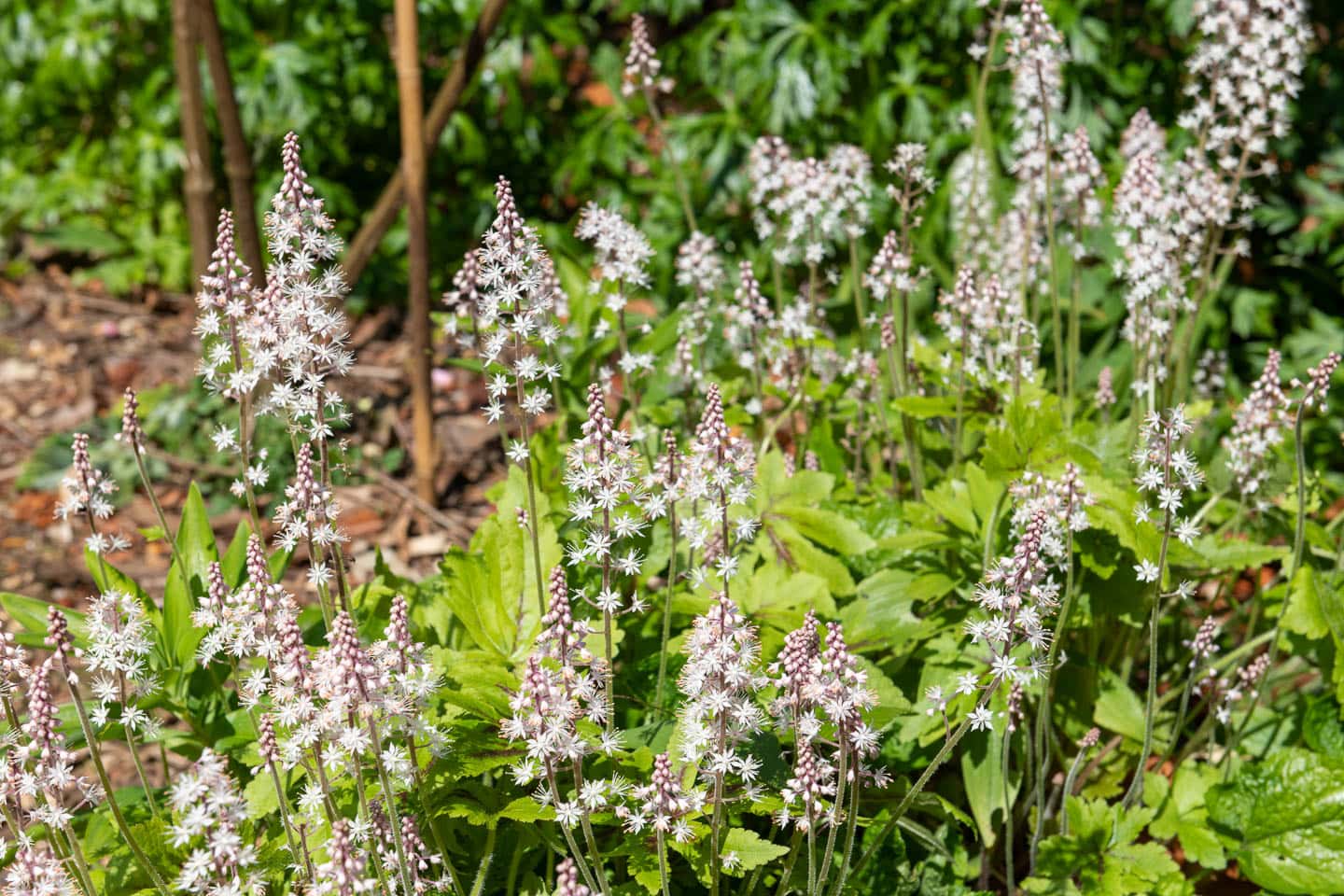
Scientific name: Tiarella
Zone: 3 to 9
Exposure: partial shade, shade
Height: 8′ – 10 “
Width: 16″ – 16″
Bloom time: spring through summer
Bloom color: pink – white
Tiarella is North American native plant that has interesting leaf shapes with striking veins.
The clumping form of tiarella produces clouds of bottle brush, pink star-shaped flowers in spring that turn white as they mature.
Green leaves turn red in autumn.
Plant foam flower in humus rich, well drained soil in the shade border or as edging along pathways.
A care free plant, it does not need division or extra fertilization.
Propagate by stolon division.
It looks lovely among spring blooming bulbs.
Foam flower attracts pollinators and is not appealing to deer and rabbits.
17 | Foamy bells
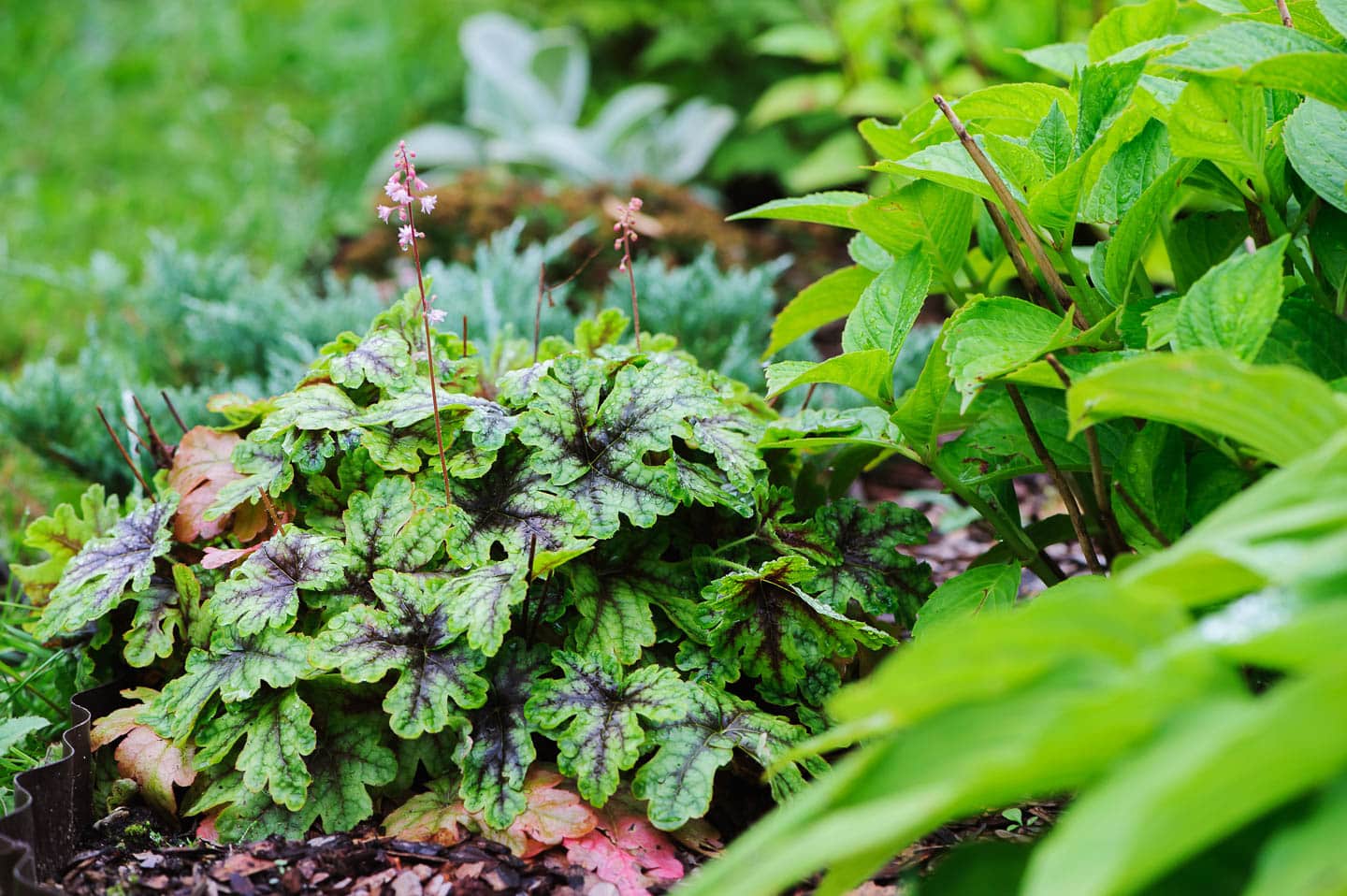
Scientific name: xHeucherella
Zone: 4 to 11
Exposure: part sun, shade
Height: 12″ – 18″
Width: 12″ – 18″
Bloom time: spring, summer
Bloom color: pink, white
Heucherella is an evergreen plant that looks similar to Heuchera for good reason.
It is actually a hybrid cross between Heuchera and Tiarella that combines traits from both parent plants to produce colorful foliage and abundant flowers.
Heucherella is a very attractive low growing mounding plant with gold/yellow, orange, green, grey/silver, or variegated, veined rounded or lobed leaves.
Abundant sprays of star-shaped flowers rise above the foliage on long stems.
Grow in rich moist soil that is high in organic matter and well draining.
They look wonderful edging paths, as specimens in rock gardens or in the woodland border mixed with ferns.
Heucherella attract birds, butterflies, bees, and hummingbirds but not deer and rabbits.
18 | Bear's Breeches, Oyster plant
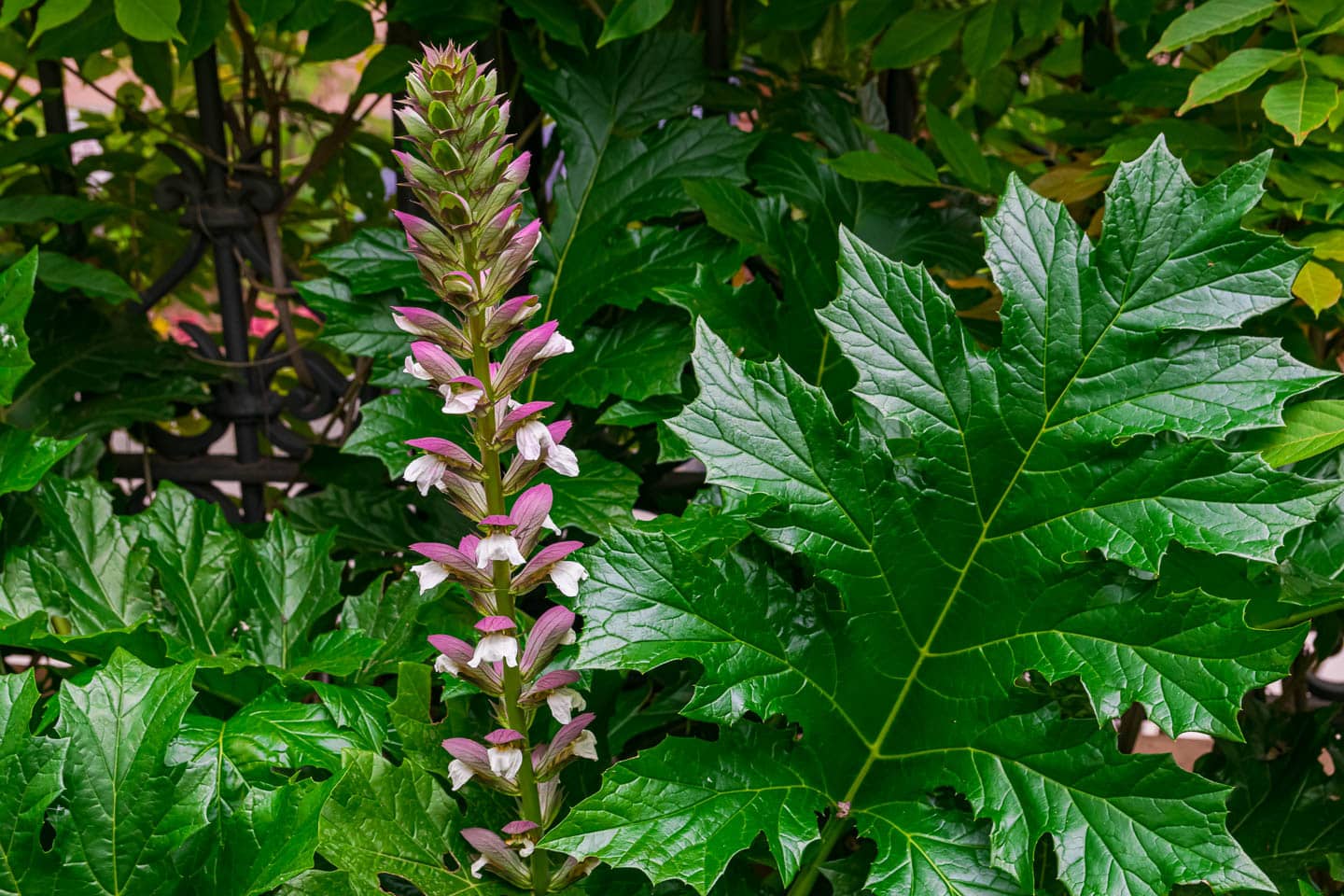
Scientific name: Acanthus mollis
Zone: 7 to 10
Exposure: partial shade
Height: 3′ – 6′
Width: 2′ – 3′
Bloom time: May – July
Bloom color: pink, purple/lavender, white
Acanthus has very attractive, shiny, dark green, deeply lobed, large leaves and amazing hooded flower spikes that resemble snap dragons.
They prefer fertile, well drained soil but will grow in any soil type except wet.
Site bear's breeches back of a border, or in an area surrounded by concrete.
This perennial makes a good specimen plant in a cottage garden.
It is difficult to move once it is established so be sure to plant it where you want it.
Acanthus mollis spreads aggressively by rhizomes and need to be contained by root barriers.
Check for invasiveness in your area before buying.
19 | Life long saxifrage, rockfoil
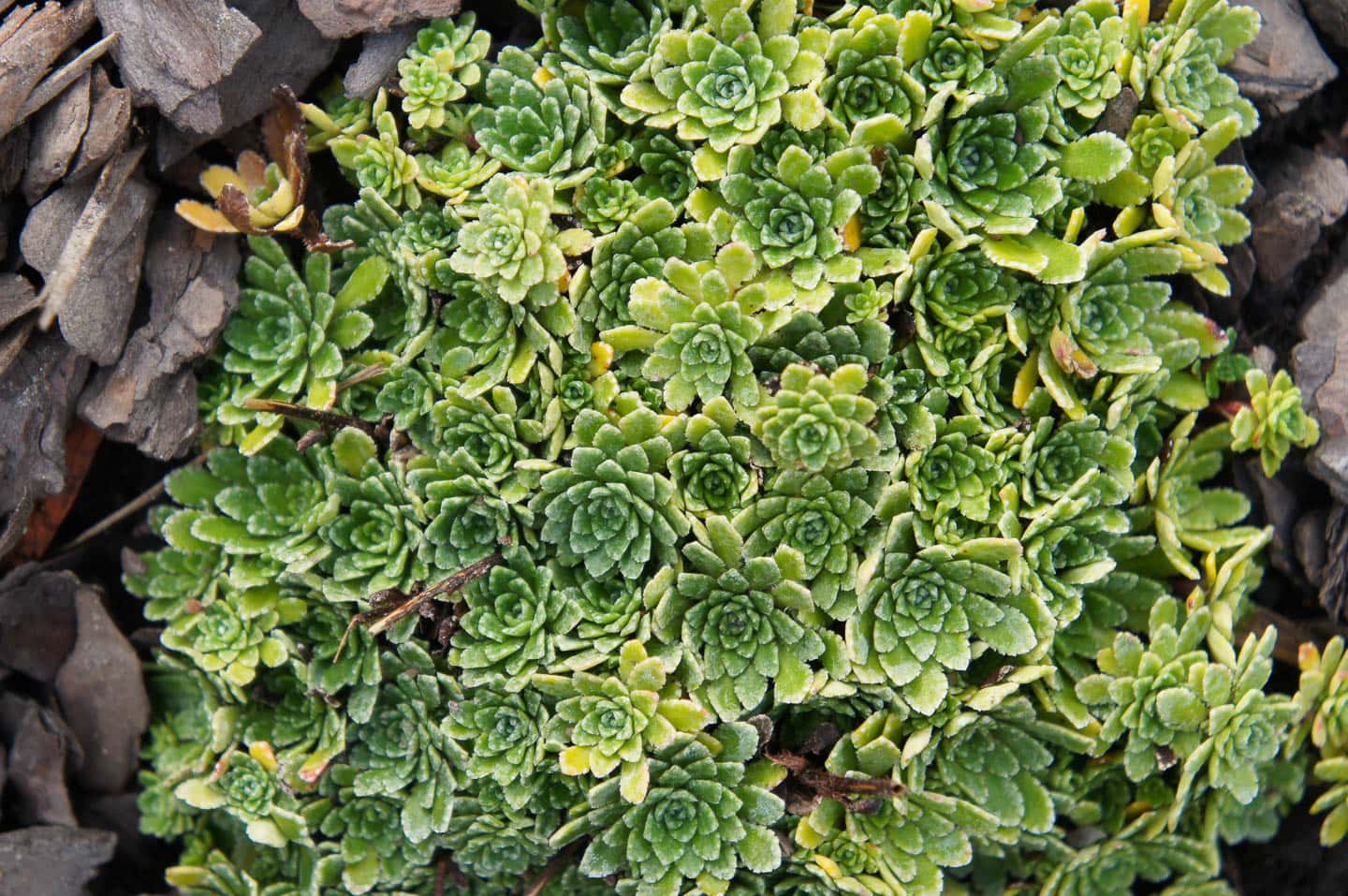
Scientific name: Saxifraga paniculata
Zone: 2 to 6
Exposure: part shade
Height: 6″ – 1′
Width: 6′ – 8′
Bloom time: late spring, early summer
Bloom color: white, pink, yellow, purple spots
Saxifraga paniculata, a North American native, is a handsome addition to rock gardens where it will slowly spread its rosettes of green leaves that sport silvery edges.
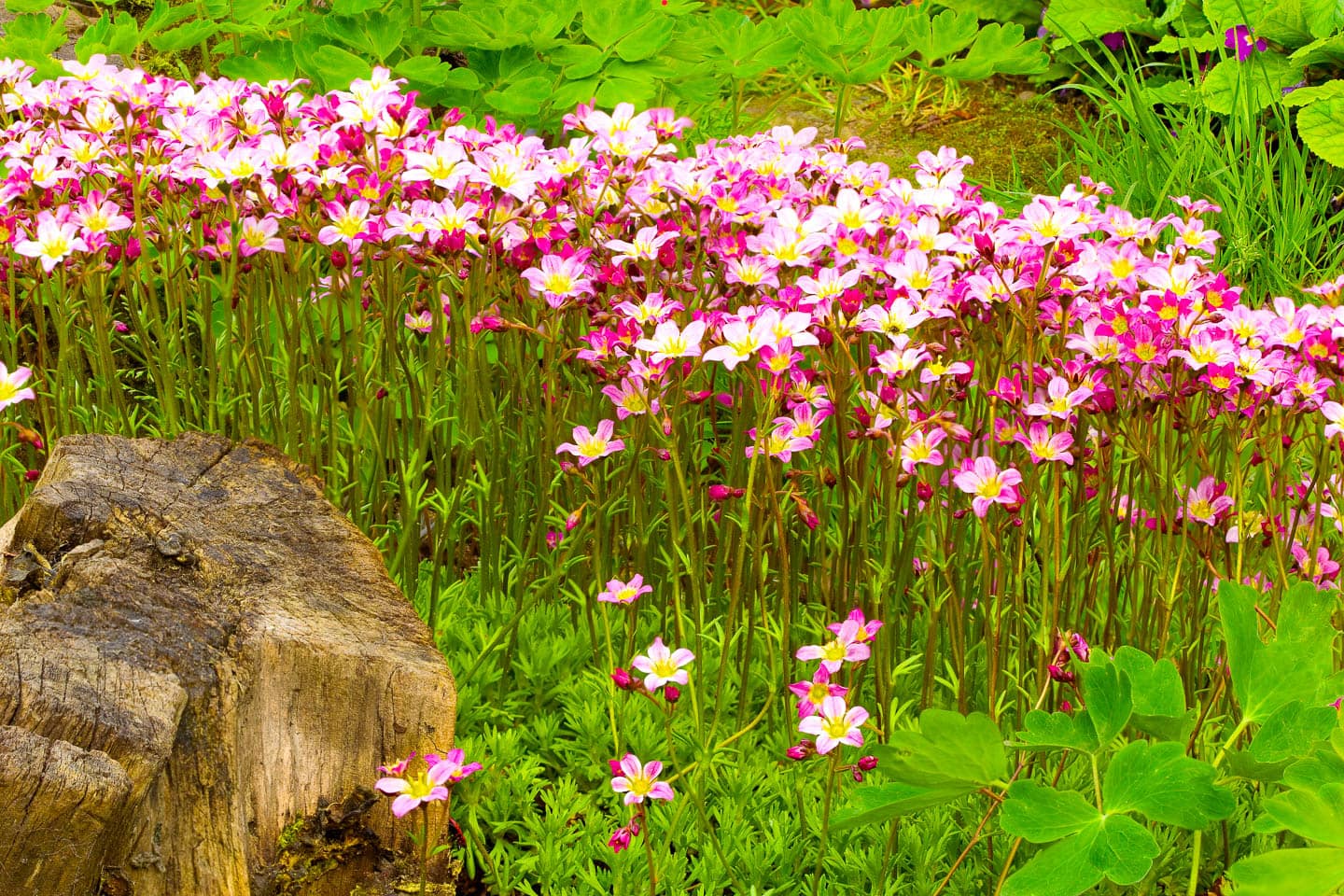
Each rosette sends up a single flower stalk that contains multiple cup- shaped little flowers.
This plant grows well in moderately fertile, sandy, slightly alkaline, well drained soil and is relatively disease free.
Propagate by separating the rosettes and planting as cuttings in spring or early summer.
There are many other low growing saxifrages available. Be sure to read the labels to distinguish between annuals, biannual and evergreen perennial varieties.
20 | Holly fern
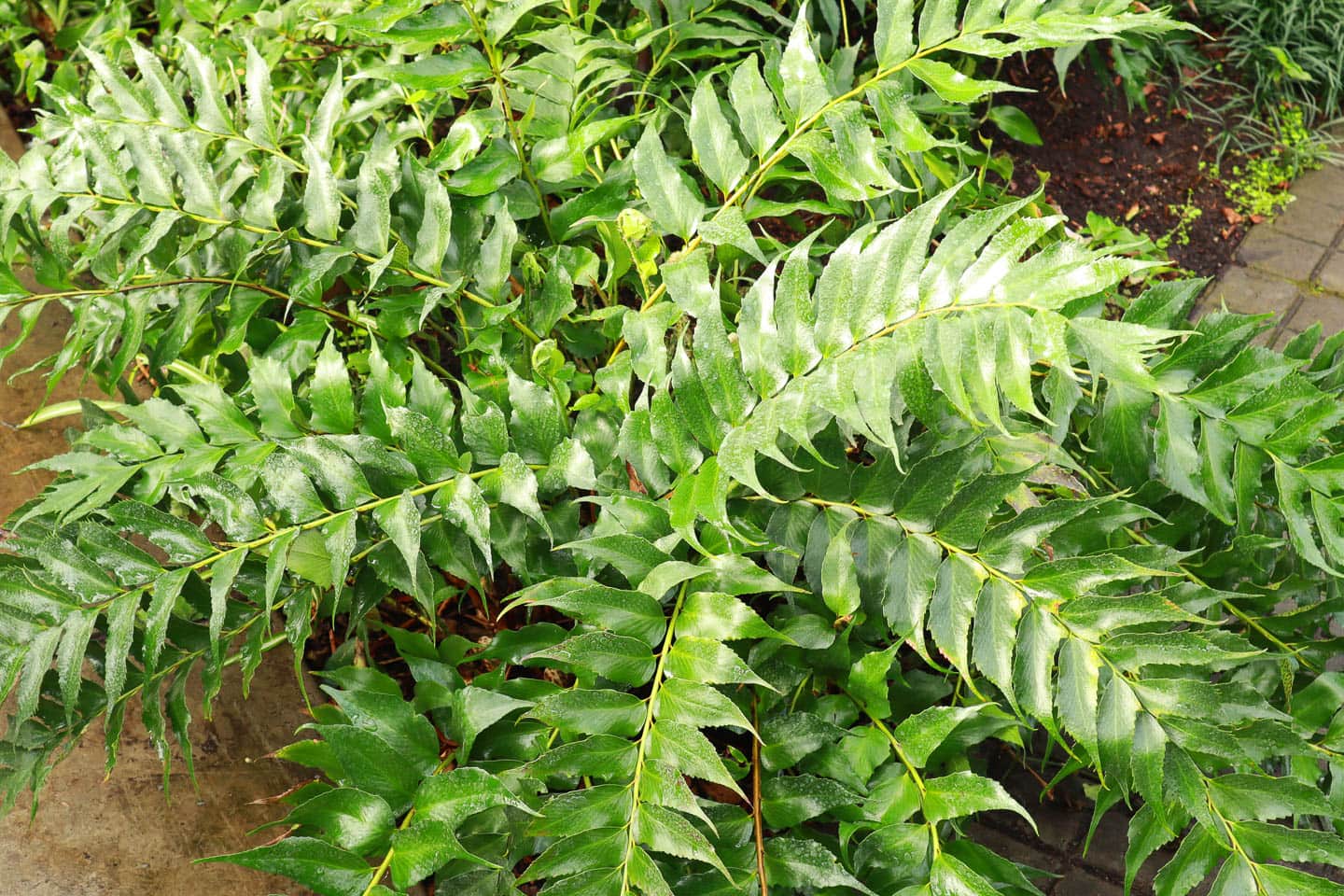
Scientific name: Cyrtomium falcatum
Zone: 6 to 11
Exposure: shade
Height: 2′ – 3′
Width: 2′ – 3′
Bloom time: not applicable
Bloom color: not applicable
Holly fern is only evergreen in zones that remain above freezing in the winter.
This large plant does well in moist humus rich soil and looks spectacular at the back of the border or in the understory of up-limbed shrubs.
It becomes quite drought tolerant after the first year.
The loose clumps comprise long, pointy, leathery, dark green fronds that are often used in floral arrangements.
Cut back winter damaged fronds in late winter. before new green growth starts.
Propagate in early spring by rhizome division.
This perennial fern was chosen as a Plant of the Year by the Florida Nursery Growers and Landscape Association (FNGLA).
That's it for our favorite shade loving evergreen perennials. Hopefully you've found a few that will work for your garden.
Other shade plants you might like
- Evergreen shrubs for shade
- Ground cover perennials for shade
- Perennials that thrive in dry shade gardens
- Tall shade perennials
Have comments or questions about our evergreen perennials for shade? Tell us in the section below.
This post was originally published on April 18, 2023 but was updated with new content on November 23, 2024.

